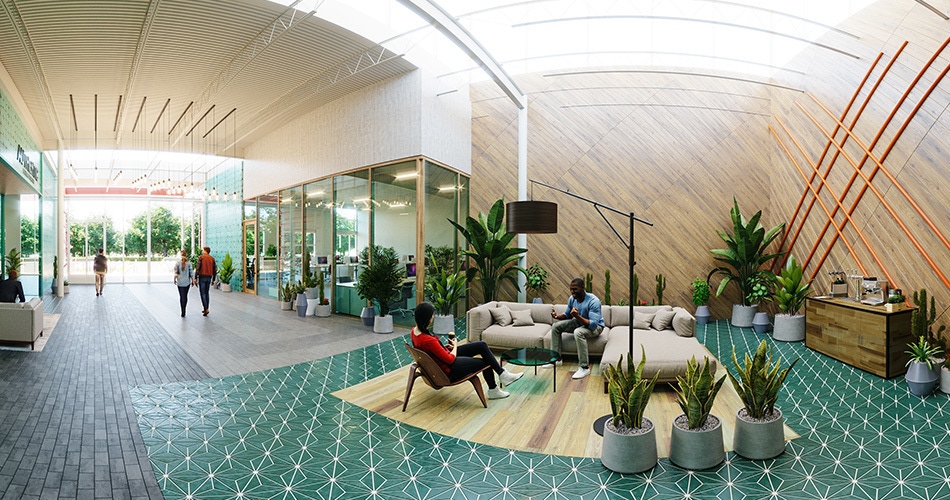
Modern augmented reality (AR) technology is changing how commercial real estate investors, stakeholders, and clients can interact with a given space.

Modern augmented reality (AR) technology is changing how commercial real estate investors, stakeholders, and clients can interact with a given space.
As many real estate professionals might tell you, investing in new commercial properties often requires vision: the ability on the part of the buyer to soak in a new space, set aside any current limitations, and embrace the potential transformation it can undergo given renovations or a refreshed workflow configuration.
Achieving this level of vision has become easier of late thanks to the amazing developments in the realm of augmented reality (AR), technology that is changing the ways in which investors, stakeholders, and clients can interact with a given space.
This article offers a brief overview of what AR is all about and highlights some of the remarkable ways in which AR technologies, including our very own Amplify platform, can revolutionize the commercial real estate industry in the not-so-distant future to accelerate entitlements, grow retail and commercial holdings, and boost the satisfaction of project stakeholders.
With the rapid advances in technologies like AR and its closely related virtual reality (VR) field, it seems valuable to share briefly what sets these two realms apart and makes AR perhaps a bit more well-suited to disrupt the real estate industry. The basic difference between the two technologies is the level of immersion of the user: while VR experiences allow the user to completely envelope themselves in an alternate reality, AR layers content on top of a real world locale to augment - as the name implies - the ways in which that space can be experienced.
This layered reality has major implications for the real estate industry because it means people can not only experience a “virtual” space they are considering, but also improve a real-life space by add digital layer for people to use and engage with. By enriching a vacant development lot, commercial complex, or neighborhood with the statistics, specifications, and proposed design concepts that buyers want at their fingertips, AR can offer buyers a streamlined experience wherein community data, comparable prices, and building features are consolidated into one easy-to-use platform.
What makes these AR applications all the more exciting is the fact that so much more of the real estate industry lives in a virtual environment. Cognizant of this trend, major commercial real estate entities and investors see AR and VR applications playing an increasingly substantial role in market’s future.
A 2018 survey performed by the Deloitte Center for Financial Services, for example, revealed that 45% of commercial real estate investors want to see a focus on the development of AR applications as a means to expand business. Given the strength of this desire for AR’s growth in the commercial real estate realm, the time is right for more pioneers in the field to explore how AR can positively impact their business.
One of the best boons of AR applications within the commercial real estate industry is that it offers developers a means to showcase a project to potential investors, stakeholders, and the community. Whether it is new construction or a renovation of an older one, AR facilities can help to boost buy-in on projects because it presents these groups with a virtual vision of what the finished space can achieve.
Early buy-in is important for stakeholders and investors, but also the community. Using AR, developers can showcase the vision of a project to the people and communities who will be using it every day, and collect feedback on what aspects of the project are more important to them. This type of community engagement not only builds better projects but also speeds up the approvals and entitlements phase of a project, adding tremendous value by reducing costs and limiting risk.
Beyond being used for visualizations of these new spaces, AR technology can enhance the physical user experience of the spaces we live and work in. One example of this are the various digital wayfinding apps being used to help people navigate cities and buildings. These types of AR tools not only help people get from place to place but can also provide helpful information about amenities, hours, services offered.

Another example points to embedded retail experiences, where AR-enabled devices allow customers to shop and explore products outside the traditional brick and mortar store. For businesses like hotels or art galleries; AR can be used to allow people to instantly purchase the interesting amenities they find in their room or a work of art they can’t resist.
This isn’t a foreign concept to modern smartphone users, either: back in 2010, Airwalk launched a pop-up store only visible to people using an AR-enabled app; one of the first of its kind. Customers were able to find the store’s secret location and then purchase exclusive items only found at the store.
Lastly, AR has the ability to create new types of captivating experiences that drive attention and awareness. AR-enabled public murals have been used to enhance the way people interact with public art, creating instantly shareable moments. When combined with the launch of a new building or public space, this type of interactive art is a great way to build excitement and generate foot traffic.
Our Amplify platform goes beyond some of the competition by offering real estate developers an optimum platform to showcase environments that haven’t yet been built. Using Amplify’s innovative platform, architects and developers can bring two-dimensional blueprints into three-dimensional or 360 reality to relay to prospective buyers and investors how splendid the space will look once constructed.

Again, it’s all about the vision, and with platforms like Amplify architecture and commercial real estate professionals can revolutionize their business by bringing the final vision of a project to life even before construction or renovation begins. Showcasing such plans can build excitement in the short term and boost investment in development opportunities in the long term as more individuals buy into the vision that AR offers them.
The full capabilities of AR technologies have yet to be realized, but for those at the forefront of the real estate market now is the time to consider the potential (take a look at these other top trends to keep in mind in real estate as well).
With the virtual landscape of the modern real estate industry ever expanding and the capabilities of our personal devices like phones and tablets alway increasing, customers are will soon expect augmented and virtual ways to interact with space.
Platforms like Amplify embrace this emerging world of mixed reality and see the potential for AR to energize the real estate development and sales fields through novel yet accessible technologies. Teaming with Amplify can bring your brand into this technology-infused era and can keep you at the forefront of this new reality.
Subscribe here to get our short and sweet monthly newsletter!